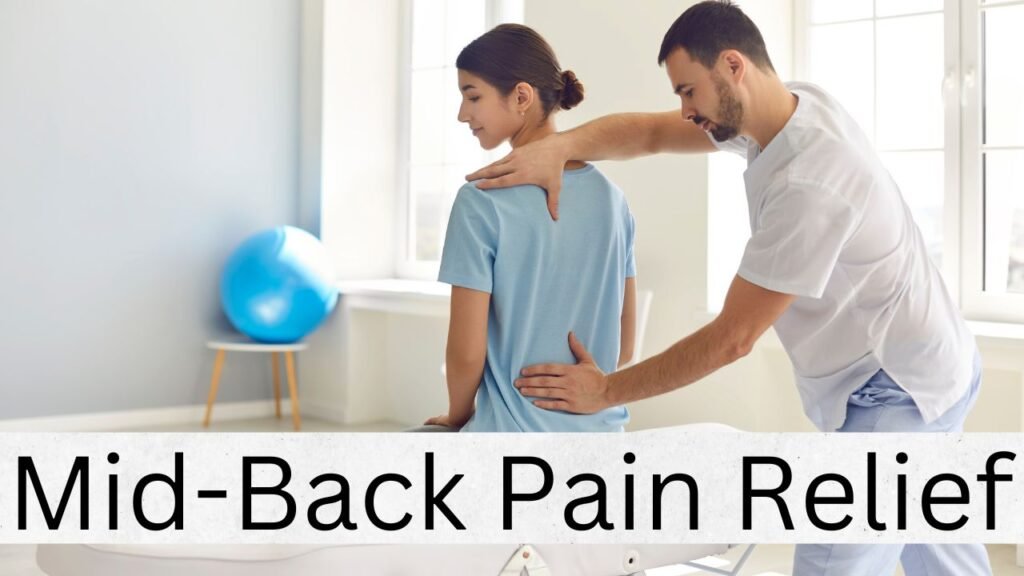Mid-back pain can be frustrating and disruptive. It affects daily activities, limits movement, and impacts overall well-being. Understanding its causes, effective treatments, and prevention strategies can help manage and reduce discomfort.

Common Causes of Mid-Back Pain
Mid-back pain stems from various sources. Identifying the cause is key to finding relief.
1. Poor Posture
Slouching or sitting for long hours strains the mid-back muscles. Over time, poor posture weakens the spine’s natural alignment, leading to stiffness and discomfort.
2. Muscle Strain
Overuse, sudden movements, or lifting heavy objects incorrectly can strain the muscles and ligaments in the mid-back.
3. Herniated Discs
A herniated or bulging disc in the thoracic spine can press on nerves, causing pain, tingling, or numbness.
4. Spinal Arthritis
Degenerative changes in the spine, such as osteoarthritis, contribute to stiffness and inflammation in the mid-back region.
5. Scoliosis
An abnormal spinal curvature can cause uneven pressure on the mid-back, resulting in chronic discomfort.
6. Stress and Tension
Emotional stress often leads to muscle tightness, particularly in the shoulders and mid-back.
7. Underlying Medical Conditions
Conditions such as kidney infections, gallbladder disease, or lung issues can sometimes cause referred pain in the mid-back.
Effective Treatments for Mid-Back Pain
Treatment depends on the cause of pain. Some cases resolve with rest, while others require targeted therapies.
1. Physical Therapy
A structured physical therapy program strengthens back muscles, improves flexibility, and corrects posture.
2. Stretching and Exercise
Gentle stretching and strengthening exercises relieve muscle tightness and support spinal health.
- Cat-Cow Stretch: Improves spinal mobility.
- Thoracic Extension Stretch: Counteracts hunching and stiffness.
- Seated Twist Stretch: Relieves tension in the mid-back.
- Strengthening Exercises: Rows and back extensions help build muscle support.
3. Heat and Cold Therapy
Applying heat relaxes tense muscles, while cold packs reduce inflammation and swelling.
4. Massage Therapy
Deep tissue massage or myofascial release techniques ease muscle knots and improve circulation.
5. Posture Correction
Ergonomic adjustments to workstations, supportive chairs, and conscious posture awareness prevent recurring pain.
6. Chiropractic Care
Spinal adjustments can realign vertebrae and relieve nerve pressure in the mid-back.
7. Pain Medication
Over-the-counter pain relievers like ibuprofen or acetaminophen help manage discomfort. In severe cases, a doctor may prescribe muscle relaxants or anti-inflammatory medications.
8. Lifestyle Changes
- Maintain a Healthy Weight: Excess weight strains the spine.
- Stay Active: Regular movement prevents stiffness and weakness.
- Improve Sleeping Habits: A supportive mattress and correct sleeping positions reduce strain on the mid-back.
- Manage Stress: Deep breathing, meditation, and relaxation techniques help prevent muscle tension.
Prevention Strategies for Mid-Back Pain
1. Maintain Proper Posture
Sit and stand with your shoulders back and spine aligned. Avoid slouching, especially when working at a desk.
2. Strengthen Core and Back Muscles
A strong core supports the spine, reducing strain on the mid-back.
3. Avoid Prolonged Sitting
Take breaks to stand, stretch, and move every 30-60 minutes.
4. Use Ergonomic Support
Invest in an ergonomic chair and workstation setup to minimize back strain.
5. Lift Properly
Use your legs, not your back, when lifting heavy objects. Keep the object close to your body and avoid twisting motions.
6. Stay Hydrated and Eat a Balanced Diet
Proper hydration and nutrition support muscle and joint health, reducing the risk of inflammation.
When to Seek Medical Help
Mild mid-back pain often resolves with self-care, but medical attention is necessary if you experience:
- Persistent pain lasting more than a few weeks
- Pain that worsens despite home treatments
- Numbness, tingling, or weakness in the arms or legs
- Difficulty breathing or chest pain
- Unexplained weight loss or fever
A healthcare provider can diagnose the underlying cause and recommend appropriate treatment.
Conclusion
Mid-back pain is common but manageable. Identifying the cause, using effective treatments, and adopting preventive habits can significantly reduce discomfort. A combination of proper posture, regular exercise, and lifestyle adjustments supports a healthy, pain-free back.